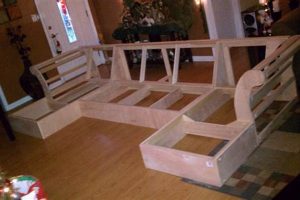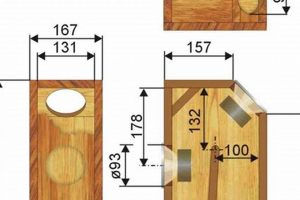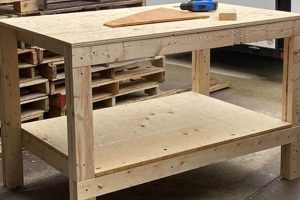Detailed instructions and blueprints designed for constructing a circular outdoor living space are considered essential tools for homeowners undertaking such a project. These resources often include step-by-step guides, material lists, and dimensional diagrams, providing a structured approach to building a paved or surfaced area in a curved shape.
The value of well-structured guidance lies in its ability to minimize errors, reduce material waste, and ensure structural integrity throughout the construction process. Historically, outdoor spaces have been designed using various techniques, but the modern approach emphasizes precision and efficiency to create aesthetically pleasing and functional areas for relaxation and entertainment, enhancing property value and usability.
The following sections will explore key aspects of planning and executing such a project, covering site preparation, material selection, construction techniques, and considerations for integrating the finished area into the overall landscape design.
Essential Considerations for a Circular Outdoor Space Construction
Successfully implementing a circular outdoor space requires careful planning and execution. The following recommendations address critical aspects of the construction process, ensuring a durable and aesthetically pleasing result.
Tip 1: Precise Measurement and Layout: Accurate measurement is paramount. Employ a central stake and string method to define the perimeter. Periodically verify the radius to maintain circularity throughout the layout phase.
Tip 2: Thorough Site Preparation: Excavate the area to the appropriate depth, accounting for base materials and the finished surface. Ensure proper soil compaction to prevent settling and instability over time.
Tip 3: Robust Base Layer Construction: A well-compacted gravel or crushed stone base provides essential drainage and support. The depth of this layer should be appropriate for the anticipated load and local soil conditions.
Tip 4: Proper Material Selection: Choose materials that are durable, weather-resistant, and aesthetically compatible with the surrounding landscape. Consider factors such as porosity, freeze-thaw resistance, and maintenance requirements.
Tip 5: Consistent Joint Spacing: Maintain uniform spacing between paving stones or bricks to ensure even weight distribution and prevent cracking. Use spacers during installation to achieve consistent results.
Tip 6: Effective Drainage Solutions: Incorporate a slight slope away from structures to facilitate water runoff. Consider installing subsurface drainage systems in areas prone to water accumulation.
Tip 7: Secure Edge Restraint: Install edge restraints to prevent the perimeter from shifting or spreading over time. These restraints should be properly anchored and constructed from durable materials.
Tip 8: Consider the Intended Use: Factor in the intended use when planning the project. Consider if it will be use for seating or a firepit, or other uses.
Adherence to these guidelines will contribute to the longevity and structural integrity of the circular outdoor space, ensuring a lasting and enjoyable addition to the property.
The subsequent section will delve into common challenges encountered during construction and effective strategies for resolving them.
1. Precise Diameter Calculation
The accurate calculation of the diameter is fundamental to the successful implementation of projects involving circular outdoor spaces. As a foundational component within “diy plans for round patio,” its influence extends directly to material requirements, spatial layout, and the overall aesthetic coherence of the finished project. An imprecise diameter value propagates errors throughout subsequent construction phases, resulting in material shortages or surpluses, misaligned paving patterns, and potential structural weaknesses. For instance, an underestimated diameter leads to inadequate paving stones or bricks to cover the designated area, while an overestimated figure generates unnecessary material expenditures. This is especially pronounced in larger scale projects.
Consider a situation in which a homeowner intends to build a circular patio with a specified seating capacity. An incorrect diameter calculation can render the space either too small to comfortably accommodate the desired number of people or excessively large, leading to underutilization of the available area and an inefficient use of resources. Further, the diameter dictates the radius, which is then used to establish the circular perimeter using the central stake and string method. Variations in the radius due to calculation errors result in an elliptical, rather than circular, final form.
In summary, precise diameter calculation is not merely an initial step but an ongoing reference point throughout the construction process. Its accuracy directly correlates with project efficiency, cost-effectiveness, and the attainment of the intended design. Challenges arise from complex site conditions or a misunderstanding of basic geometric principles; these challenges can be mitigated by thorough planning and seeking professional guidance when necessary.
2. Material Quantity Estimation
Material quantity estimation is a critical phase in the implementation of “diy plans for round patio”. It directly impacts project cost, minimizes waste, and ensures timely completion. Accurate estimation allows for the procurement of necessary materials in the right amounts, avoiding both shortages that can halt construction and surpluses that lead to unnecessary expenses.
- Surface Area Calculation
The primary determinant of material needs is the surface area of the planned circular outdoor space. This calculation requires precise measurements of the diameter or radius, from which the area is derived using the formula r. For instance, a significant miscalculation of the radius translates into a squared error in the area, leading to substantial discrepancies in material requirements.
- Material Coverage Rates
Different materials possess varying coverage rates, dictating how much area a unit of the material can cover. Paving stones, gravel base, and edging restraints each have unique coverage characteristics. Failure to account for these differences results in under or over-ordering. For example, overlapping pavers or a thicker-than-necessary gravel base consume more material per unit area.
- Waste Factor Incorporation
Construction inevitably generates waste due to cuts, breakage, or installation errors. A waste factor, typically expressed as a percentage, is added to the estimated material quantities to compensate for this. The waste factor varies based on material type and installation complexity; intricate patterns or fragile materials require a higher waste allowance. Neglecting this aspect often leads to shortages mid-project.
- Depth and Volume Considerations
Materials like gravel base and sand leveling layers are quantified by volume, not surface area. Accurate estimation necessitates calculating the required depth of each layer and converting this depth into a total volume needed for the entire area. Insufficient base material compromises the structural integrity of the patio, while excessive material increases project costs without adding value.
The interconnectedness of these aspects underscores the importance of thorough planning and careful calculations when executing “diy plans for round patio.” Accurate material quantity estimation is not merely a cost-saving measure but a cornerstone of project success, ensuring efficient resource allocation and a durable, aesthetically pleasing outdoor space.
3. Optimal Site Preparation
Optimal site preparation forms a critical foundation for the successful implementation of “diy plans for round patio.” The degree to which the site is properly prepared directly influences the structural integrity, longevity, and aesthetic appeal of the finished outdoor space. Neglecting this phase introduces potential for settling, drainage issues, and premature deterioration of the patio surface. Proper site preparation encompasses several key stages, each contributing to the overall stability and functionality of the project. These include removing vegetation and topsoil, leveling the ground, compacting the subgrade, and installing a suitable base material. For instance, if topsoil is not adequately removed, its organic matter will decompose over time, leading to uneven settling and potential cracking of the patio surface. Similarly, inadequate compaction of the subgrade creates a weak foundation susceptible to movement under load. The selection and installation of an appropriate base material, such as crushed stone or gravel, ensures proper drainage and distributes weight evenly, preventing localized sinking or shifting of paving stones.
Consider a scenario where a homeowner, in an effort to expedite the construction process, bypasses thorough site preparation. The resulting patio may initially appear satisfactory, but within a short period, issues such as uneven surfaces, pooling water, and displaced paving stones begin to manifest. Correcting these problems requires significant effort and expense, often exceeding the cost of proper site preparation in the first instance. Furthermore, optimal site preparation contributes to the overall efficiency of the construction process. A level and well-compacted base simplifies the laying of paving stones or other surface materials, reducing installation time and minimizing material waste. The use of appropriate tools and techniques, such as a plate compactor and laser level, further enhances the quality and precision of site preparation.
In summary, optimal site preparation is not merely a preliminary step but an integral component of “diy plans for round patio.” Its impact extends beyond the initial construction phase, influencing the long-term performance and visual appeal of the outdoor space. Addressing potential challenges, such as unstable soil conditions or poor drainage, requires careful planning and execution. By prioritizing thorough site preparation, homeowners can ensure a durable, aesthetically pleasing, and functional patio that enhances the value and enjoyment of their property.
4. Effective Drainage Integration
Effective drainage integration is a non-negotiable aspect of “diy plans for round patio.” The absence of a properly designed drainage system precipitates a cascade of detrimental effects, compromising structural integrity, aesthetic appeal, and long-term usability. A patio situated without adequate drainage is susceptible to water accumulation, leading to material degradation, frost heave, and the proliferation of mold and mildew. Therefore, designing for effective drainage from the outset is paramount.
- Surface Runoff Management
Surface runoff refers to the flow of rainwater or snowmelt across the patio surface. Effective management involves creating a subtle slope, typically a quarter-inch per foot, to direct water away from structures and towards designated drainage points. Failure to incorporate adequate slope results in standing water, accelerating material deterioration and creating potential slip hazards. A real-world example includes directing water away from a home’s foundation to prevent water damage and structural issues.
- Subsurface Drainage Systems
Subsurface drainage systems address water that permeates the patio surface or accumulates beneath it. These systems typically involve the installation of perforated pipes surrounded by gravel, which collect and channel water away from the area. A poorly designed subsurface system can lead to waterlogging, weakening the base materials and causing the patio surface to become uneven. For example, installing a French drain along the perimeter of the patio can effectively intercept groundwater and prevent hydrostatic pressure buildup.
- Material Permeability Considerations
The choice of patio materials directly influences drainage characteristics. Permeable paving stones or gravel surfaces allow water to infiltrate the ground, reducing runoff and minimizing the need for extensive drainage systems. Impermeable materials, such as concrete or tightly fitted pavers, require more robust drainage solutions to manage surface water. Selecting appropriate materials based on site conditions and drainage requirements is crucial. A common example involves using permeable pavers in areas with high rainfall to minimize stormwater runoff and replenish groundwater.
- Integration with Existing Landscape
Effective drainage integration extends beyond the patio itself, encompassing the surrounding landscape. Directing water from the patio into existing drainage swales, rain gardens, or dry wells can provide a sustainable and aesthetically pleasing solution. However, it is essential to ensure that the receiving areas have sufficient capacity to handle the increased water flow. Improper integration can lead to erosion, flooding, and damage to surrounding vegetation. An example includes directing patio runoff into a rain garden filled with native plants that absorb excess water and filter pollutants.
These facets, when carefully considered and implemented, ensure that “diy plans for round patio” result in outdoor spaces that are not only visually appealing but also durable and resistant to water-related damage. A comprehensive drainage strategy, tailored to the specific site conditions and material choices, is an investment in the long-term performance and enjoyment of the patio.
5. Circular Pattern Installation
The correct implementation of a circular pattern is central to achieving the intended aesthetic and structural characteristics of a circular outdoor space. When integrated with “diy plans for round patio,” this phase determines the visual appeal and contributes significantly to the patio’s overall durability.
- Centering and Layout Precision
Establishing a precise center point and radius is fundamental to circular pattern installation. Deviations from accuracy at this initial stage propagate throughout the entire layout, resulting in distortions and an uneven appearance. The central point serves as the anchor for all subsequent measurements and placements, dictating the symmetry and proportionality of the pattern. For example, utilizing a fixed stake and string method ensures consistent radius measurements, mitigating errors that arise from freehand estimation or imprecise tools. An error in centering directly affects the visual balance, especially noticeable in patterns with radial symmetry.
- Material Alignment and Spacing
Consistent alignment and spacing of paving materials are crucial for creating a visually harmonious and structurally sound surface. Irregularities in alignment disrupt the intended pattern, while inconsistent spacing introduces stress points that can lead to cracking or shifting over time. Spacers or templates ensure uniformity in joint widths, maintaining the integrity of the circular design. The selection of appropriate jointing material further contributes to the long-term stability and aesthetic appeal. Inconsistent material alignment can lead to an unorganized look, especially when using complex paving patterns.
- Cutting and Shaping Techniques
Circular designs necessitate precise cutting and shaping of materials to conform to the curved perimeter and internal features. Accurate cuts are essential for creating seamless transitions and maintaining the integrity of the intended pattern. Specialized tools, such as wet saws or angle grinders, facilitate the cutting of paving stones or bricks to the required dimensions and angles. Neglecting this aspect results in unsightly gaps, misaligned edges, and a compromised aesthetic. For example, radial patterns require tapered cuts to maintain a consistent joint width as the pattern expands outwards from the center.
- Pattern Complexity and Material Choice
The complexity of the chosen pattern directly influences the level of skill and precision required for installation. Simpler patterns, such as concentric circles or basic radial arrangements, are more forgiving of minor errors, while intricate designs demand meticulous attention to detail. The selection of appropriate materials, in terms of size, shape, and color, further impacts the visual impact and ease of installation. For instance, using smaller paving stones allows for greater flexibility in accommodating curves and intricate details. Complex pattern installations could require more cutting and fitting stones.
These facets, when addressed with precision and skill, ensure that the resulting circular patio is not only visually striking but also durable and functional. The integration of effective installation techniques, tailored to the specific pattern and materials chosen, is crucial for maximizing the longevity and enjoyment of the outdoor space.
Frequently Asked Questions on Circular Outdoor Living Construction
The following questions address common concerns and misconceptions regarding the planning and execution of circular outdoor living spaces.
Question 1: What are the primary advantages of circular outdoor area designs over rectangular configurations?
Circular designs often promote more intimate social interactions due to the natural orientation of seating arrangements. Additionally, they can offer a softer aesthetic that integrates more seamlessly with organic landscaping.
Question 2: Is specialized equipment necessary for constructing a circular outdoor area?
While not always mandatory, certain tools such as wet saws for precise material cuts and plate compactors for soil stabilization can significantly improve the quality and efficiency of the build.
Question 3: How does soil type impact the construction of a circular outdoor area?
The soil composition directly influences drainage and stability. Expansive clay soils require careful management to prevent heaving, whereas sandy soils necessitate thorough compaction to ensure a solid base.
Question 4: What are the most common mistakes made during the construction of such spaces, and how can they be avoided?
Frequent errors include inaccurate radius measurements, inadequate site preparation, and insufficient drainage. These can be mitigated by meticulous planning, the use of accurate tools, and adherence to established construction techniques.
Question 5: How can one effectively integrate a circular outdoor area into an existing landscape design?
Consider the existing style, colors, and materials. Using complementary elements and ensuring a smooth transition between the new space and the surrounding landscape are key to a cohesive design.
Question 6: What maintenance strategies are essential for preserving the integrity and appearance of a circular outdoor area?
Regular cleaning to prevent algae or moss growth, periodic joint stabilization, and prompt repair of any cracks or settling are crucial for long-term maintenance.
In summary, successful implementation depends on diligent planning, precise execution, and a commitment to ongoing maintenance.
The subsequent section will explore potential design ideas and stylistic considerations.
diy plans for round patio Conclusion
This exploration has elucidated the multifaceted nature of diy plans for round patio. The effectiveness of such plans hinges on meticulous diameter calculation, precise material estimation, optimal site preparation, integrated drainage solutions, and skilled circular pattern installation. Each phase demands careful attention to detail, employing appropriate techniques and materials to ensure structural integrity and aesthetic appeal.
The successful realization of such a project necessitates a commitment to accuracy and thoroughness. By adhering to established principles and addressing potential challenges proactively, individuals can create durable and visually appealing outdoor spaces that enhance property value and provide lasting enjoyment. Further research and consultation with experienced professionals are encouraged for those embarking on complex or technically challenging projects.







